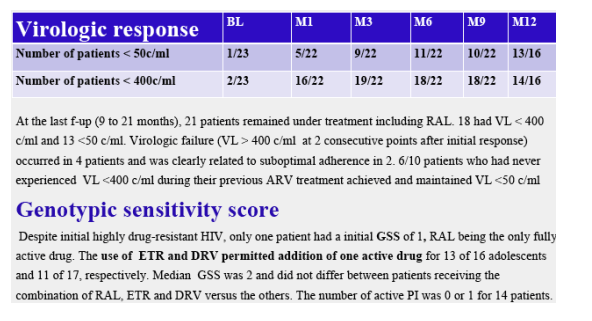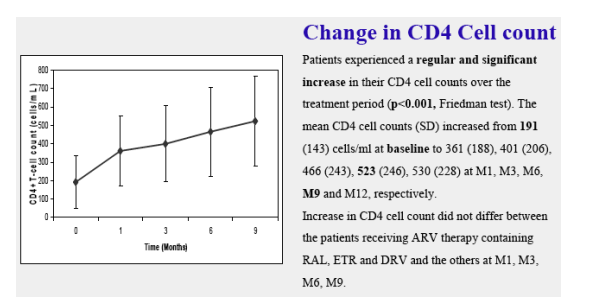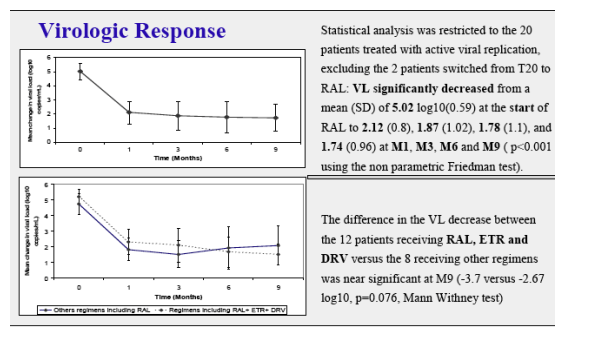 |
 |
 |
| |
Raltegravir In Children and Adolescents: The French Expanded Access Program
|
| |
| |
Reported by Jules Levin CROI 2009 Feb 8-12
Isabelle Thuret*1, C Tamalet2, V Reliquet3, G Firtion4, P Frange5, J Tricoire6, H Aumaitre7, C Rabaud8, M-L Chaix5, and S Blanche9
1Hematologie Pediatrique APHM, Marseille, France; 2Laboratoire de Virologie, APHM, Marseille, France; 3Hematologie Pediatrique CHU Nantes, France; 4Service d'Infectiologie, CHU Cochin, APHP, Paris, France; 5Laboratoire de Virologie, Hopital Necker, APHP, France; 6Pediatrie, CHU Toulouse, France; 7Service de gastro-enterologie, CH Perpignan, france; 8Infectiologie, CHU Nancy, France; and 9Hematologie Pediatrique Hopital Necker, APHP, Paris France
Author Conclusions
All patients aged less than 18 years treated in France during the RAL expanded access for highly drug- resistant HIV infection were included in this report. With 1 year median follow-up under treatment:
-Virologic response was remarkable suggesting that most extensive treatment experienced but integrase inhibitor-naive adolescents can achieve viral control when the salvage regimen also contains other active agents. Despite the small number of patients, a trend in favor of a higher decrease in VL for patients receiving RAL+ETR+DRV was observed with time, compared with those treated with other regimens..
-A high immunologic response was obtained among these immunosuppressed patients with a long past history of treatment failure and a median initial CD4 cells < 200 cells/ml.
-As in adult patients, a good safety profile of the different regimens including RAL was noted.
Durability of viral suppression in these heavily pre-treated adolescents should be assessed in the long term but would be optimized by the combined use of ETR and/or DRV with RAL.
Background: From December 2006 to December 2007, 23 consecutive adolescents with multidrug- resistant HIV1 were treated in France with raltegravir (RAL) on compassionate grounds in line with regulatory statement granted by the French health authority before market commercialization of a drug. RAL was used in combination with other antiretroviral drugs including for 13 patients both etravirine (ETV) and darunavir (DRV), these 2 drugs also being delivered via a similar expanded access.
Methods: The 23 patients had a median age of 15.5 years (range 12 to 17) and have been HIV-infected since birth. They had previously received a median of 6 NRTI (range 5 to 7) and 4 PI (2 to 7), all except 1 patient had been treated with 1 or 2 NNRTI, and 13 have received enfuvirtide. A history of AIDS was recorded for 17 patients; 21 of the patients were treated because of active replication of multidrug-resistant virus (median HIV-1 RNA level of 5 log10 copies/mL). The number of antiretroviral drugs prescribed in combination with RAL was 2 to 5. ETV was used in 16 patients, DRV in 17 and both drugs in 13.
Results: The median follow-up of treatment including RAL was 9 months (6 to 18) for 22 patients. Treatment of 1 patient was interrupted after 3 weeks because of headache. No additional moderate-to-severe clinical side effect and no grade 3 or 4 laboratory abnormalities occurred. At the last follow-up, HIV-1 RNA load was <400 copies/mL in 19 of the 22 (86%) and <50 copies/mL in 15 (68%). At baseline and month 1, 3, 6, 9, and 12 the numbers of patients who had <400 copies/mL HIV-1 RNA were 2 of 23, 16 of 22, 19 of 22, 18 of 22, 12 of 14, 6 of 8, and who had <50 copies/mL were 1 of 23, 5 of 22, 9 of 22, 11 of 22, 7 of 14, 5 of 8. The median genotypic sensitivity score, determined retrospectively at the start of RAL treatment was 2 (range1 to 4) with no or only 1 active PI in 14 cases. The use of ETV and DRV permitted addition of 1 active drug for 13 of 16 patients and 11 of 17, respectively. Median CD4 cell counts increased progressively from 194 cells/mL at baseline to 297, 342, and 402 at month 1, 3, and 6, respectively (p <0.001). In the first adolescents treated in real-life practice with RAL, combined with ETV or DRV in 20 cases, a potent antiretroviral effect and a good safety profile were observed.
Conclusions: Despite very long periods of viral replication on previous ART and large spectra of resistance, virological success was obtained for most patients at the last follow-up.


Clinical Results
Follow-up data were obtained for 22 patients out 23, treatment containing RAL being discontinuated by one patient after 2 weeks. For the 22 remaining patients, the median treatment duration was 12 months (9 -21 months). During this time, their mean SD score for weight increased significantly from -0.82 SD (-2.63 to +1.4) to -0.46 SD (-2.9 to +1.81) (p=0.006, wilcoxon test). No death or AIDS-defining clinical events occurred. A second patient permanently stopped RAL at 9 months because of virologic failure. At the time of analysis (Oct 2008) 21 patients remained under treatment including RAL.
Safety
Except for the patient who definitively stopped treatment at 2 weeks because of sleep disorders, nausea and headache, no clinical side effects were noted. No laboratory abnormalities of grade 3 or 4 occurred. One patient had initial anemia (grade 2) and another neutropenia (grade 1): both remained unchanged. Liver abnormalities were initially present in 3 patients and remained unchanged or improved subsequently. Mild increase in fasting triglyceride levels appeared in 3 patients/18 evaluated while in 3 others, previously treated with LPV, TG levels improved.
Characteristics of the patients at the start of RAL
The 23 patients (17 males , 6 females ) treated with RAL-ATU, have been HIV-1 infected since birth. They had median age and duration of previous ARV therapy of 15.5 yrs (range 12-17) and 13 yrs (10- 17). Their median weight was 48 kg (range 28-72). A history of AIDS was recorded for 17 patients and 22 were or have been immune class3. CD4 cells number ranged from 5 to 484 (median: 194 cells/ml). All patients were heavily pretreated and 22 had genotype-documented triple-class oral drug resistance: median number of drugs received was 6 (range 5-7) and 4 (range 2-7) for NRTI and PI. All patients except one had received 1 or 2 NNRTI drugs.. Enfuvirtide has been previously used in 13 patients.
21 of the patients were treated via RAL -ATU because of active replication of multidrug resistant virus (median HIV-1 RNA level of 5 log 10 copies/ml range 3.34 to 6.1) but 2 patients had viral control on treatment including enfuvirtide and switched to RAL because of injection-site reactions. 10 adolescents had never experienced an undetectable VL during their previous ARV treatment history.

|
| |
|
 |
 |
|
|